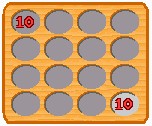Mr Mancala (talk | contribs) No edit summary |
Mr Mancala (talk | contribs) m (Protected "Conga" ([edit=autoconfirmed] (indefinite) [move=autoconfirmed] (indefinite))) |
||
| (2 intermediate revisions by the same user not shown) | |||
| Line 51: | Line 51: | ||
*[http://www.abstractstrategy.com/conga.html Conga at abstractstrategy.com] |
*[http://www.abstractstrategy.com/conga.html Conga at abstractstrategy.com] |
||
*[http://www.boardgamegeek.com/game/26948 Conga at BoardGameGeek] |
*[http://www.boardgamegeek.com/game/26948 Conga at BoardGameGeek] |
||
| + | *[http://en.wikipedia.org/wiki/Wikipedia:Articles_for_deletion/Conga_(board_game) Wikipedia articles for deletion (archived discussion)] |
||
==Copyright== |
==Copyright== |
||
| − | ''© Wikimanqala.<br /> |
+ | ''© [[Wikimanqala]].<br /> |
| − | By: Ralf Gering<br /> |
+ | By: [[User:Mr Mancala|Ralf Gering]]<br /> |
Under the [http://creativecommons.org/licenses/by-sa/2.5/ CC by-sa 2.5 license].'' |
Under the [http://creativecommons.org/licenses/by-sa/2.5/ CC by-sa 2.5 license].'' |
||
| − | |||
[[Category:Two-dimensional Sowing Games]] |
[[Category:Two-dimensional Sowing Games]] |
||
Latest revision as of 06:19, 18 April 2011
Conga → German.
| Conga |
 Conga Board & Counters |
| Inventor: Martin Franke, 1995 |
| Ranks: Four by Four |
| Sowing: Single laps |
| Region: Germany |
Conga was invented by Martin Franke in 1995 while he was a student of design in Germany and was described in his Diplom thesis in 1996. At this time the game was still called "Celim" and one variation was played on a 8x8 grid. A commercial set was published in 1998 by "Das Spiel Hamburg".
Franke lives in Dortmund, Germany.
Conga is a two-dimensional sowing game, which combines the move characteristics of mancala games with the goal of Four-in-a-Row.
The game suffers under a strong first move advantage.
A similar looking game is Due conGa by Frank Stark (2005). However, this is not a sowing game.
Rules
The game is played on a board of 4x4=16 holes.
At the start there are 10 seeds in a corner hole opposite each other. One player owns the black seeds, the other the white seeds.
Black starts the game.
Initial Position
Each turn a player empties a hole which contains seeds of his color and distributes them in one direction, diagonally or orthogonally. He sows one seed into the following hole, two into the next and the rest into the last one. It is not permitted to put seeds into holes which are occupied by the opponent. If the edge of the board or a hole occupied by the opponent is reached, the move is terminated early by dropping the seeds into the last legal hole. There must be at least one hole into which seeds can be played to make a play into that direction.
No seeds can be captured.
The object of the game is to form a row of four occupied holes (the colors of the seeds don't matter), diagonally or orthogonally.
If a player has no legal move because his seeds are blocked, he has lost.
References
- Hartogh, T.
- Brettspiele aus aller Welt: Neu entdeckt. Falken Verlag, Niedernhausen (Germany) 2000, 63-64.
External Links
- Official homepage
- Conga at abstractstrategy.com
- Conga at BoardGameGeek
- Wikipedia articles for deletion (archived discussion)
Copyright
© Wikimanqala.
By: Ralf Gering
Under the CC by-sa 2.5 license.
